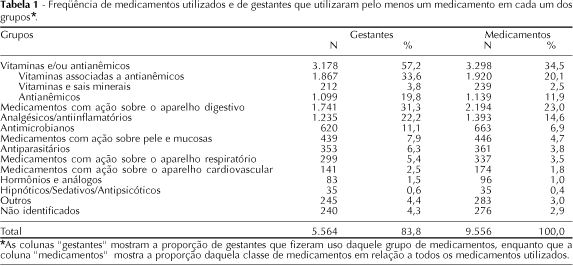OBJECTIVE: To describe drugs used during pregnancy by women attending prenatal clinics of the national public health system (SUS) in Brazilian cities. METHODS: Using a structured questionnaire, 5,564 pregnant women between the week 21 to 28 who attended prenatal visits of the SUS in six Brazilian cities were interviewed. The interview questions were grouped in "guided use" to cover pain, cramps, nausea, cough, and others, and "guided medicine" to cover vitamins, iron, and fluoride. The Food and Drug Administration gestational risk classification (1991-1995) was applied. RESULTS: Of a total of 5,564 women, 4,614 (83.8%) used at least one drug during pregnancy, with a total of 9,556 drugs used. The drugs most frequently used were vitamins associated with anti-anemics (33.5%), gastrointestinal drugs (31.3%), analgesics and anti-inflammatory drugs (22.2%), anti-anemics (19.8%), and antibiotics (11.1%). Regarding gestational risk, 3,243 drugs used (34%) belonged to category A risk, 1,923 (22.6%) to category B, 3,798 (39.7%) to category C, 289 (3.0%) to category D, and 55 (0.6%) to category X. CONCLUSIONS: A large variation in drug use across the cities was observed, especially for anti-anemics and vitamins associated with anti-anemics, revealing the lack of a national consensus regarding the use of these drugs during pregnancy. There was no literature data about safety during pregnancy for 12.9% of the drugs used. This percentage, plus the 26.9% of category C drugs, shows that 40% of the drugs used during pregnancy do not belong to the approved safety categories. However, only 3% of the 9,956 drugs used were clearly contraindicated during pregnancy.
Drug utilization; Pregnancy; Prenatal care



